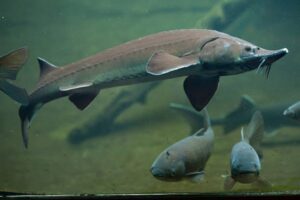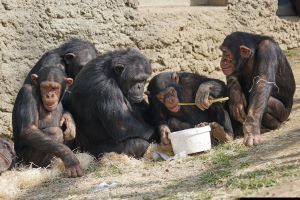
It is generally believed that Nature is ruthless. If any wild creature is sick or injured it is always left to die or is actually killed by its companions rather than become a liability to them. This is not strictly true. Many creatures act as their own doctors (Healers) in an attempt to cure themselves.
It is known that a cat or dog will eat grass if its stomach is upset, but other animals also eat various leaves and grasses for their medicinal value. They always pick special plants and avoid all others. This seems to suggest that the animals have acquired a knowledge of the value of herbal treatment.
Some years ago a man who caught a gibbon noticed it had a curious swelling on its side over which ran a long scar. Curious to see what was wrong the man had the animal operated upon. The swelling proved to be a large ball of masticated leaves from a plant known for its medicinal value. The ape had obviously been wounded and had gathered the leaves, chewed them into a ball and stuffed them into its open wound. This appeared to have done the trick and helped heal the injury.
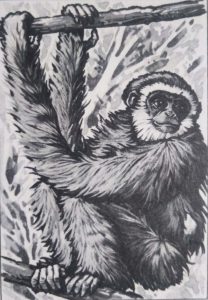
Splint
A moorhen was once found with its leg bound with a kind of plaster cast at the knee joint. The bone had been broken but had grown together again and was fully healed, but the cast of dried clay must have been put there by the bird itself. Woodcock birds are alleged to have been seen doing the same thing, applying a splint of stiff grasses and clay to an injured limb. First-aid of another kind is seen in the ant world, where a worker with a broken leg will have it amputated by its fellows. Ants also isolate and tend sick members of their communities in special chambers in the nest.
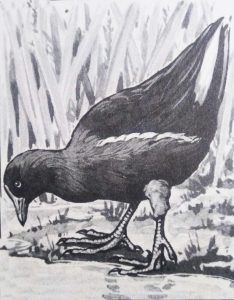
Black bears and other creatures coming out of hibernation in the spring are known to search for and eat certain berries and fruits which have a laxative effect. This is presumably to tone up their body systems after their long sleep.
Deer prefer lime-filled water when growing new antlers so that these will grow quickly, while pregnant mule deer will eat only certain kinds of food until their young are born. Many other creatures will search for certain leaves and roots when they are ailing.
Animals with bleeding wounds have been known to place spiders’ webs on them. These have styptic properties which constrict the blood vessels and reduce bleeding. And the tiny, and to us ‘unpleasant’, maggots which crawl in their hundreds inside the naked wound of some animals are never disturbed by the creature itself. Laid by mayflies, these maggots actually destroy dangerous bacteria in the wound and assist natural healing. Perhaps a case of animals knowing better than Man, for we would be unlikely to let maggots get near any of our wounds!
But not only are there animals who act as their own doctors on occasion; some also perform as dentists. Apes sometimes act as skilled dentists on their own and each other’s teeth.
An orang-utang performed such a feat of self-treatment. Kept in semi-captivity it was noticed one day dejectedly holding its cheek. In fact, it had actually applied a lump of damp clay as a cold poultice to its face to soothe a gumboil in its mouth. A few days later it pulled out a rotten tooth which it showed to its master with obvious pleasure.
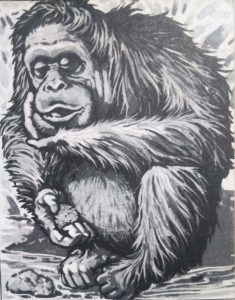
Chimpanzees in particular practise more skilled dentistry — inspecting, cleaning and even extracting teeth. American scientists have observed many bouts of dental grooming among a group of older chimps kept in a large outdoor enclosure, four of them using what can only be described as primitive dental implements.
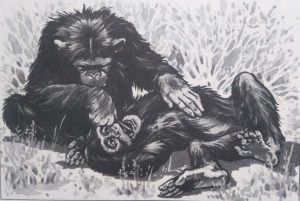
Clean
In one instance, an eight-year-old female opened the mouth of a younger male, who co-operated fully by gaping his jaws. She removed food particles using her two forefingers like forceps. Then she picked up a short twig with which to clean the ‘patient’s’ teeth further. Usually the patient’s head was steadied with one hand and dental work performed with the other. Often the sticks were peeled of leaves, trimmed or had their ends chewed off before use.
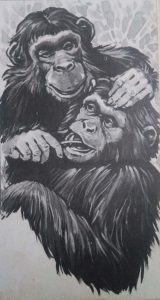
On another occasion, a chimpanzee carefully extracted a fellow ape’s loose tooth using a pine twig. The patient lay flat on the ground and the ape ‘dentist’ sat close alongside his head, carefully performing the extraction in about 90 seconds. The only difference from a human dentist was that the considerate chimps did regularly hold the twig implements in the mouth like a cigarette, using them and their bare fingers alternately!
Only by such scientific research, involving groups of animals in a reasonably wild state, will we gain a further insight into this fascinating and valuable aspect of animal behaviour. Perhaps then we will fully understand that in Nature it is not always a case of ‘survival of the fittest’. For it seems that — within certain groups of animals at least — there is still a chance for the lame and infirm.
There are several examples of natural healers found in nature. Here are a few examples along with information on how they work to promote healing:
Copied
Echinacea
Echinacea is a flowering plant often used in herbal medicine to boost the immune system. It contains compounds that have been found to stimulate the production of white blood cells and enhance the body's defense mechanisms. Echinacea is commonly used to prevent or alleviate symptoms of colds, flu, and other respiratory infections.
Aloe Vera
Echinacea is a flowering plant often used in herbal medicine to boost the immune system. It contains compounds that have been found to stimulate the production of white blood cells and enhance the body's defense mechanisms. Echinacea is commonly used to prevent or alleviate symptoms of colds, flu, and other respiratory infections.
Aloe Vera is a succulent plant known for its healing properties. It contains a gel-like substance in its leaves that can be applied topically to treat burns, wounds, and various skin conditions. Aloe Vera has anti-inflammatory and antimicrobial properties that help reduce inflammation, soothe the skin, promote cell regeneration, and speed up the healing process.
Copied
Echinacea
Echinacea is a flowering plant often used in herbal medicine to boost the immune system. It contains compounds that have been found to stimulate the production of white blood cells and enhance the body's defense mechanisms. Echinacea is commonly used to prevent or alleviate symptoms of colds, flu, and other respiratory infections.
Honey
Echinacea is a flowering plant often used in herbal medicine to boost the immune system. It contains compounds that have been found to stimulate the production of white blood cells and enhance the body's defense mechanisms. Echinacea is commonly used to prevent or alleviate symptoms of colds, flu, and other respiratory infections.
Honey is a natural sweetener produced by bees from the nectar of flowers. It has been used for centuries for its healing properties. Honey possesses antimicrobial properties, which can help in preventing infections and promoting wound healing. It also has anti-inflammatory effects and can soothe sore throats and coughs.
Copied
Echinacea
Echinacea is a flowering plant often used in herbal medicine to boost the immune system. It contains compounds that have been found to stimulate the production of white blood cells and enhance the body's defense mechanisms. Echinacea is commonly used to prevent or alleviate symptoms of colds, flu, and other respiratory infections.
Lavender
Echinacea is a flowering plant often used in herbal medicine to boost the immune system. It contains compounds that have been found to stimulate the production of white blood cells and enhance the body's defense mechanisms. Echinacea is commonly used to prevent or alleviate symptoms of colds, flu, and other respiratory infections.
Lavender is an aromatic plant known for its relaxing scent. Its essential oil is commonly used in aromatherapy and for promoting relaxation and reducing anxiety. Lavender also possesses anti-inflammatory and antimicrobial properties that can be beneficial for treating minor burns, skin irritations, and promoting better sleep.
Turmeric
Copied
Echinacea
Echinacea is a flowering plant often used in herbal medicine to boost the immune system. It contains compounds that have been found to stimulate the production of white blood cells and enhance the body's defense mechanisms. Echinacea is commonly used to prevent or alleviate symptoms of colds, flu, and other respiratory infections.
Echinacea is a flowering plant often used in herbal medicine to boost the immune system. It contains compounds that have been found to stimulate the production of white blood cells and enhance the body's defense mechanisms. Echinacea is commonly used to prevent or alleviate symptoms of colds, flu, and other respiratory infections.
Turmeric is a spice derived from the Curcuma longa plant. It contains an active compound called curcumin, which has potent anti-inflammatory and antioxidant effects. Turmeric has been used in traditional medicine to ease joint pain, reduce inflammation, improve digestion, and boost overall health.
Chamomile
Copied
Echinacea
Echinacea is a flowering plant often used in herbal medicine to boost the immune system. It contains compounds that have been found to stimulate the production of white blood cells and enhance the body's defense mechanisms. Echinacea is commonly used to prevent or alleviate symptoms of colds, flu, and other respiratory infections.
Echinacea is a flowering plant often used in herbal medicine to boost the immune system. It contains compounds that have been found to stimulate the production of white blood cells and enhance the body's defense mechanisms. Echinacea is commonly used to prevent or alleviate symptoms of colds, flu, and other respiratory infections.
Chamomile is an herb commonly consumed as a tea. It has been used for centuries due to its calming and sedative properties. Chamomile contains compounds called flavonoids, which have anti-inflammatory and antioxidant effects. These properties make chamomile effective in promoting relaxation, easing digestive issues, and reducing inflammation when applied topically.
Echinacea
Copied
Echinacea
Echinacea is a flowering plant often used in herbal medicine to boost the immune system. It contains compounds that have been found to stimulate the production of white blood cells and enhance the body's defense mechanisms. Echinacea is commonly used to prevent or alleviate symptoms of colds, flu, and other respiratory infections.
Echinacea is a flowering plant often used in herbal medicine to boost the immune system. It contains compounds that have been found to stimulate the production of white blood cells and enhance the body's defense mechanisms. Echinacea is commonly used to prevent or alleviate symptoms of colds, flu, and other respiratory infections.
Echinacea is a flowering plant often used in herbal medicine to boost the immune system. It contains compounds that have been found to stimulate the production of white blood cells and enhance the body’s defense mechanisms. Echinacea is commonly used to prevent or alleviate symptoms of colds, flu, and other respiratory infections.
It’s important to note that while these natural healers can have beneficial effects, they may not replace professional medical treatments. Consulting with a healthcare provider is always recommended for proper diagnosis and treatment.
Traditional cultures in Healing
Traditional cultures throughout history have often relied on nature’s healers for medicinal purposes. These cultures observed and learned from their surroundings, identifying various plants, herbs, and other natural substances that possessed medicinal properties. They developed knowledge, techniques, and practices for preparing and administering these remedies to treat various ailments.
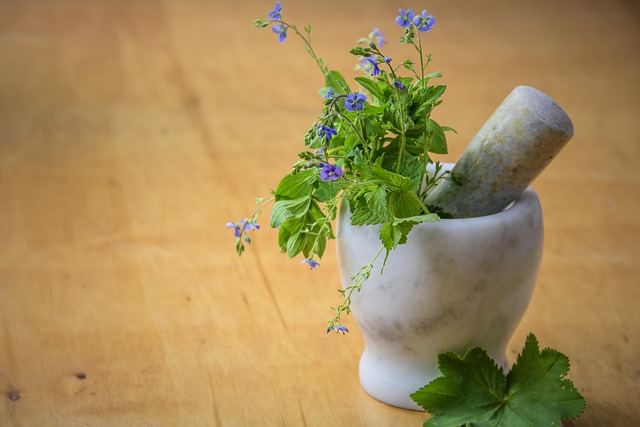
For example, ancient Chinese, Ayurvedic, and Native American cultures have a long history of using herbs, plants, and minerals to promote healing. Traditional Chinese Medicine (TCM) revolves around the concept of balance and uses herbs, acupuncture, and other techniques to restore the body’s equilibrium. Ayurveda, an ancient Indian system of medicine, emphasizes a holistic approach that incorporates herbs, nutrition, meditation, and yoga. Native American healing practices incorporate the use of medicinal plants and rituals to bring physical, mental, and spiritual healing.
These traditional practices are often still relevant in today’s modern world. Many of the natural substances and remedies used by traditional cultures have been scientifically studied and validated for their effectiveness. For instance, aspirin was derived from willow bark, which was used by the ancient Egyptians and Greeks for pain relief. Many modern drugs, such as morphine and taxol, have roots in traditional herbal medicine.
Moreover, traditional healing practices offer holistic approaches that focus on treating the root cause of an ailment, rather than just the symptoms. They consider the interconnectedness of the mind, body, and spirit and strive to restore balance and harmony. In this era of increasing interest in holistic health and alternative therapies, traditional healing practices are experiencing a resurgence.
However, it is important to note that while traditional practices may have valuable insights, not all remedies are scientifically proven or safe. Some traditional practices may not align with modern medical guidelines or may result in cultural appropriation if not used with proper understanding and respect. Therefore, it is crucial to seek guidance from qualified practitioners and integrate traditional practices with evidence-based modern medicine for optimal health outcomes.
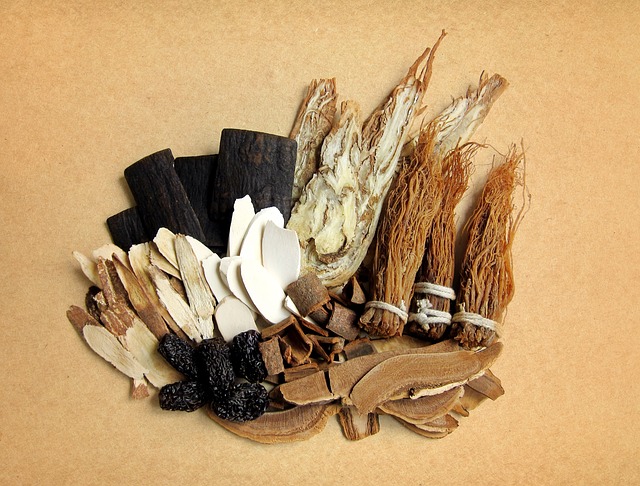

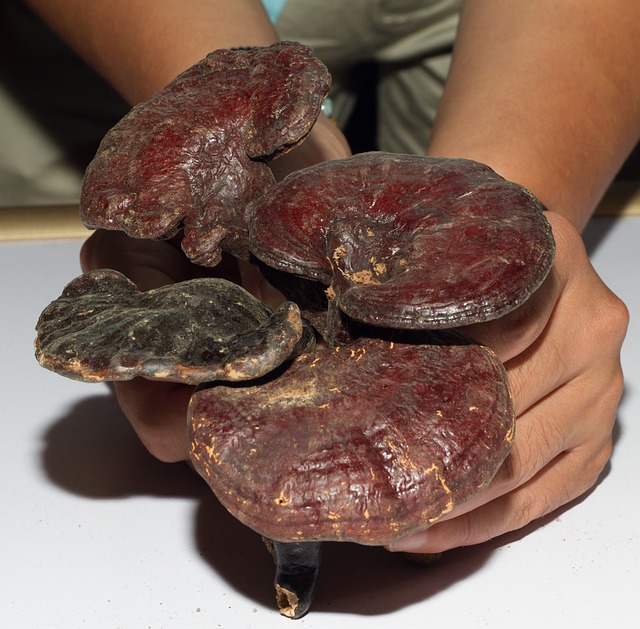

Nature's healers encompass a wide range of natural elements
Nature’s healers refer to the natural elements and resources present in the environment that have the ability to promote healing and wellbeing for both the body and mind. Throughout history, humans have relied on these healers to alleviate various ailments and maintain a balanced state of health.
One of nature’s most prominent healers is plants. The plant kingdom offers a wide array of medicinal herbs, trees, and flowers that possess powerful healing properties. Traditional systems of medicine such as Ayurveda, Traditional Chinese Medicine, and Native American healing practices all utilize plants to create remedies for various health conditions. For example, aloe vera is known for its soothing and healing properties on the skin, while chamomile and lavender have calming effects and can help with insomnia and anxiety. Many plants also contain antioxidants, vitamins, and other compounds that support the body’s immune system, reduce inflammation, and enhance overall vitality.
Natural elements found in the earth also play a vital role in healing. Minerals like magnesium, iron, and zinc are required for numerous bodily functions and can be obtained through the consumption of nutrient-rich foods such as fruits, vegetables, and whole grains. Mineral-rich mud and clays are used in healing practices like mud baths and face masks, as they can detoxify the body, improve skin conditions, and alleviate joint pain.
Another essential element of nature’s healers is water. Water has been used for centuries for its therapeutic properties. Hydropathy, the use of water to treat diseases, has been practiced in various cultures. Different water treatments like hydrotherapy, steam baths, and cold plunges can promote circulation, detoxification, relaxation, and rejuvenation. The minerals present in natural spring water are also believed to have healing effects when consumed or used topically.
The healing power of nature is not limited to physical ailments alone; it also extends to mental and emotional well-being. The practice of spending time in nature, often called ecotherapy or forest bathing, has gained significant attention in recent years. Being in natural environments, such as forests, mountains, or bodies of water, has been shown to reduce stress, improve mood, and enhance cognitive function. The sights, sounds, and smells of nature can have a calming and grounding effect on the mind and can help alleviate symptoms of mental health disorders like anxiety and depression.
Nature’s healers also include animals. Interaction with animals has been shown to lower blood pressure, reduce stress, and increase levels of oxytocin, a hormone associated with bonding and happiness. Animal-assisted therapy is increasingly being used in various healthcare settings to help individuals cope with physical and mental health challenges. For example, therapy dogs are often brought to hospitals or nursing homes to provide comfort and companionship to patients.
Nature’s healers encompass a wide range of natural elements, including plants, minerals, water, and animals. These elements possess unique properties that can be harnessed to support physical, mental, and emotional well-being. The power of nature’s healers has been recognized and utilized by humans for centuries, and continues to offer a holistic and sustainable approach to healing and maintaining health.
Wild Animals' Incredible Abilities
Wild animals have long been known for their incredible ability to heal themselves in the face of injury or illness. These natural healers utilize a combination of instinct, adaptation, and innate bodily mechanisms to fight off pathogens, mend wounds, and restore their health.
One of the most remarkable aspects of nature’s healing abilities in wild animals is their immune system. Just like human beings, animals possess a complex network of cells, tissues, and organs that work together to identify and neutralize harmful invaders such as bacteria, viruses, and parasites. However, what sets animals apart is the efficiency and resilience of their immune responses. Due to their exposure to diverse pathogens in their environment, animals have developed robust immune systems that enable them to mount rapid and effective immune responses against a wide range of threats.
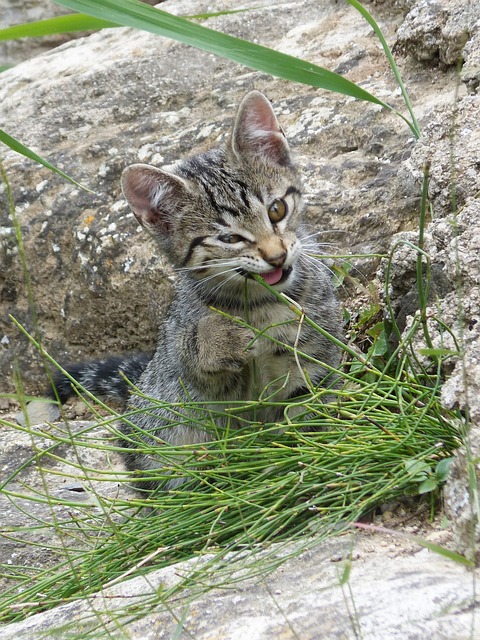
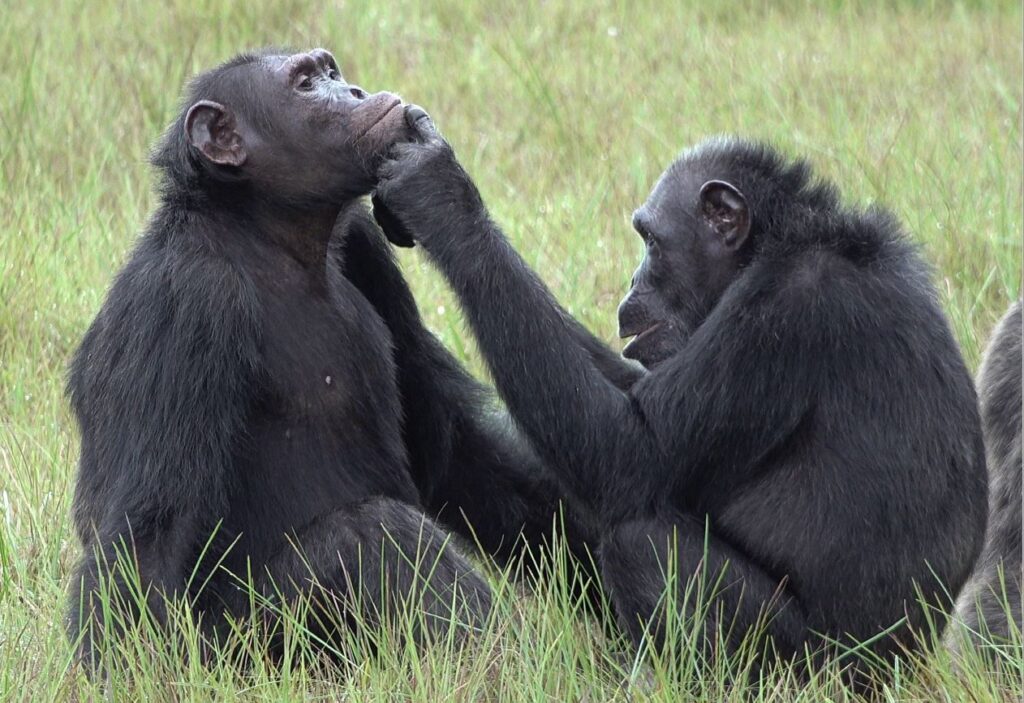
In addition to their powerful immune systems, wild animals also possess an array of physiological adaptations that aid in healing. For instance, many animals have an increased capacity for tissue regeneration. This means that when they sustain injuries, their body can regenerate and replace damaged tissue, allowing them to heal quickly. Some animals, like lizards and starfish, even have the remarkable ability to regenerate entire limbs if they are severed.
Another fascinating healing mechanism present in wild animals is their ability to use natural substances to treat their ailments. For example, some animals actively seek out medicinal plants or specific minerals to address digestive issues or to combat parasitic infestations. Observations have shown that certain monkeys and apes consume specific types of leaves when they are suffering from gastrointestinal problems. Similarly, certain birds have been observed ingesting soil rich in minerals to aid their digestion and detoxification processes.
The behavior of wild animals also plays a significant role in their healing. Some animals, such as dolphins and elephants, have been observed engaging in social behaviors that promote healing. Dolphins, for instance, have been known to support injured or sick members of their pod, swimming alongside them and providing physical contact, which is believed to have both psychological and physiological healing effects. Elephants, with their strong familial bonds, also exhibit similar behaviors when an individual is injured or ill, surrounding the individual and offering support and comfort.
Beyond physical healing mechanisms, animals also display a remarkable psychological resilience that aids in their recovery. Unlike humans, animals do not dwell on their injuries or illnesses; instead, they focus on survival and adapting to their environment. This mental toughness allows them to bounce back quickly after injuries or illness, enabling their bodies to heal more rapidly.
Nature’s healers in wild animals are awe-inspiring manifestations of the complex processes that exist in the animal kingdom. Their powerful immune systems, regenerative abilities, natural substance utilization, social behaviors, and psychological resilience all contribute to their remarkable healing capabilities. Observing and studying the healing behaviors of wild animals not only deepens our understanding of the natural world but also serves as a source of inspiration for optimizing our own healing processes.
There are several examples of wild animals that possess healing abilities and employ them to treat themselves or others. Here are a few:
-
01
Chimpanzees
Chimpanzees have been observed using different plants for medicinal purposes. They often chew the leaves of certain plants, such as Aspilia, to create a foam that they then rub into their fur. This is believed to act as an insect repellent, preventing parasitic infestations.
-
02
Dolphins
Dolphins have been known to help injured or sick individuals within their pods. They support and push the weak or injured companion to the water’s surface to aid in breathing, preventing drowning. This behavior exhibits social care and assistance.
-
03
Elephants
Elephants have a remarkable ability to detect when another member of their group is injured or sick. They use their trunks to touch and investigate the wounded area, showing empathy and concern. Additionally, elephants have been known to self-medicate by consuming certain plants as a way to alleviate digestive issues and stomach ailments.
CopiedElephantsElephants have a remarkable ability to detect when another member of their group is injured or sick. They use their trunks to touch and investigate the wounded area, showing empathy and concern. Additionally, elephants have been known to self-medicate by consuming certain plants as a way to alleviate digestive issues and stomach ailments.
-
04
Honeybees
Honeybees produce and use propolis, a substance made from tree resins mixed with wax and bee saliva. They employ propolis to seal cracks and repair damages within their hives. Propolis acts as a natural antimicrobial agent, protecting the hive from harmful bacteria and viruses.
-
05
Vampire bats
Vampire bats have a unique healing ability related to their feeding behavior. They possess anticoagulant properties in their saliva, aiding in blood flow and preventing it from clotting while they feed on their prey. This ability helps them avoid complications that could arise from consuming blood.
CopiedVampire batsVampire bats have a unique healing ability related to their feeding behavior. They possess anticoagulant properties in their saliva, aiding in blood flow and preventing it from clotting while they feed on their prey. This ability helps them avoid complications that could arise from consuming blood.
These examples demonstrate the various ways in which wild animals have developed healing abilities to treat themselves or other members of their species. However, it’s important to note that further research is needed in some cases to fully understand these abilities and their mechanisms.
Scientists have studied and documented the healing behaviors of wild animals through various methods, including field observations, controlled experiments, and the use of technology such as camera traps and GPS tracking devices. These studies have provided valuable insights into the potential benefits and mechanisms behind these behaviors.
One common healing behavior observed in wild animals is self-medication, where animals actively seek out specific plants, minerals, or other natural substances to treat ailments. For example, chimpanzees have been observed consuming certain plants to expel parasites from their digestive tract, while elephants often seek out specific tree barks which have anti-inflammatory properties.
In terms of methods, scientists have used ethnozoology, which involves studying traditional knowledge and practices of indigenous people who have observed healing behaviors of wild animals for generations. This approach has been particularly useful in understanding the medicinal properties of various plants and the specific uses by animals in the wild.
Scientists have also conducted controlled experiments in captive environments to validate the healing behaviors observed in the wild. For instance, researchers have observed birds adding antimicrobial substances like cigarette butt fibers to their nests, and then placed synthetic fibers in their nests to study the potential antimicrobial benefits.
Researchers have discovered several potential benefits and mechanisms behind these behaviors. Firstly, self-medication behaviors in animals can effectively treat and prevent diseases. By ingesting certain plants or substances, animals can eliminate parasites, reduce inflammation, and boost their immune system.
Secondly, the presence of anti-inflammatory and antimicrobial compounds in medicinal plants and minerals has been confirmed through chemical analysis. For instance, certain plants used by chimpanzees have been found to have high concentrations of antiparasitic agents.
Thirdly, it has been observed that healing behaviors are often passed down through generations, suggesting a cultural transmission of knowledge, similar to human societies. This indicates that animals can acquire and adapt these behaviors over time, enhancing their chances of survival and overall health.
Studying and documenting the healing behaviors of wild animals have revealed fascinating insights into self-medication, traditional knowledge, and the potential benefits and mechanisms behind these behaviors. Such research not only expands our understanding of animal behavior but also holds potential for the development of novel medicines and treatments for human health.
Frequently Asked Questions "Nature's Healers" :
Nature’s Healers refer to the natural healing abilities that wild animals possess. These healing abilities can range from physical adaptations, such as regenerative capabilities, to behavioral patterns that aid in recovery from injuries or illnesses.
Wild animals have evolved various mechanisms to self-heal. Some animals possess regenerative abilities, where they can regenerate lost or damaged tissues, organs, or limbs. For instance, salamanders can regrow their tails or limbs, and starfish can regenerate their arms. Other animals have developed efficient immune systems that can effectively combat infections or illnesses. Additionally, certain behavioral patterns, such as grooming and self-medication, can also contribute to self-healing in wild animals.
Self-medication refers to the intentional ingestion of certain plants, minerals, or other substances by wild animals to treat or prevent illnesses or infections. Animals exhibit innate knowledge about the healing properties of certain natural substances and seek them out when they are unwell. For example, chimpanzees consume specific herbs to eliminate internal parasites or relieve gastrointestinal distress.
Yes, wild animals may alter their diets to aid in their healing process. They instinctively seek out specific food sources that contain medicinal or nutritional properties. For instance, some animals will consume certain plants, fruits, or insects that possess antimicrobial or anti-inflammatory compounds to combat infections or reduce pain and inflammation.
Yes, many wild animals use natural remedies to heal wounds. For example, certain birds are known to use specific plants or tree resins to create a therapeutic paste that they apply to their damaged feathers. This acts as a natural adhesive that aids in the healing and strengthening of the feathers.
Yes, wild animals have been observed using natural remedies for reproductive health. For example, pregnant elephants have been seen chewing on branches from the Commiphora tree, which contains compounds that mimic progesterone, a hormone necessary for maintaining pregnancy. Similarly, some primates consume plants with estrogen-like properties to regulate their reproductive systems.
Wild animals have remarkable healing abilities, but their capacity to recover from serious injuries or diseases may vary. Some animals, such as reptiles, can regenerate entire body parts, allowing them to recover from severe injuries. Certain species, like whales or dolphins, also exhibit remarkable resilience and can heal from wounds caused by predator attacks or boat collisions. However, it’s important to note that not all injuries or diseases can be healed completely, and some may result in long-term or permanent consequences for the animal.
Studying Nature’s Healers in wild animals can provide valuable insights for human medicine and healthcare. By understanding the mechanisms behind natural healing processes, scientists can develop new treatments and therapies for humans. For instance, studying the regenerative abilities of certain animals may lead to advancements in regenerative medicine to aid human tissue repair and regrowth. Additionally, exploring natural remedies used by animals can inspire the development of new medications derived from plant or animal compounds.
As humans, we can contribute to the well-being of Nature’s Healers in several ways. Respecting and protecting natural habitats is crucial to ensure the survival and health of wild animals. Avoiding activities that can harm or disturb wildlife, such as illegal hunting or habitat destruction, helps in maintaining the balance of ecosystems. Supporting organizations dedicated to wildlife conservation and rehabilitation is another way to actively contribute to the well-being of Nature’s Healers. Additionally, raising awareness about the importance of wildlife conservation and the need to preserve natural habitats can also make a positive difference in the lives of wild animals.



























